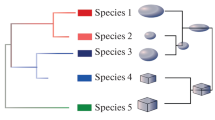Abstract
The richness of endemic species is often recognized as an indication of the distinctiveness of certain local faunas and is used for the definition of conservation hotspots as well. Faunas of different animal taxa were considered in sets of contiguous geographical units. Comparing the faunas of different units in one set, we found an exponential increase in the number of endemics when plotted against the number of non-endemics. A model of independent stochastic population dynamics under the control of environmental oscillations produces random fluctuations in the ranges of species. Ranges of endemic species are supposedly narrower than ranges of co-occurring non-endemic species. In such a case, the flow of a random process leads to an exponential relationship between numbers of co-occurring endemic and non-endemic species. This process also produces an apparent positive correlation between total species number and the percentage of endemics.
Similar content being viewed by others
References
Anderson S. 1994. Area and Endemism. Q. Rev. Biol. 69: 451–471.
Bishop Museum 2002. http://www2.bishopmuseum.org/HBS/checklist/query.asp?grp=Arthropoda (accessed 10.10.2006)
Böhning-Gaese K., Caprano T., van Ewijk K. & Veith M. 2006. Range size: Disentangling current traits and phylogenetic and biogeographic factors. Am. Nat. 167: 555–567. DOI 10.1086/501078
Chikatunov V., Pavlíček T. & Nevo E. 1999. Coleoptera of “Evolution Canyon”, Lower Nahal Oren, Mt. Carmel, Israel. Part I. Pentsoft, 174 pp.
Chikatunov V., Pavlíček T. & Nevo E. 2004. Coleoptera of “Evolution Canyon”, Lower Nahal Oren, Mt. Carmel, Israel. Part II. Pentsoft, 192 pp.
Coad B.W. & Vilenkin B.Ya. 2004. Co-occurrence and zoogeography of the freshwater fishes of Iran. Zool. Middle East 31:53–61.
Cox D.R. & Smith W.L. 1971. Queues. 2nd ed. Chapman and Hall, London, 180 pp.
Emerson B.C. & Kolm N. 2005. Species diversity can drive speciation. Nature 434: 1015–1017. DOI 10.1038/nature03450
Furth D.G. 1979. Zoogeography and host plant ecology of the Alticinae of Israel, especially Phyllotreta; with descriptions of three new species (Coleoptera: Chrysomelidae). Israel J. Zool. 28: 1–37.
Gaston K.J. 2000. Global patterns in biodiversity. Nature 405: 220–227. DOI 10.1038/35012228
Gaston K.J. & Blackburn T.M. 2002. Large-scale dynamics in colonization and extinction for breeding birds in Britain. J. Anim. Ecol. 71: 390–399. DOI 10.1046/j.1365-2656.2002.00607.x
Graves G.R. & Rahbek C. 2005. Source pool geometry and the assembly of continental avifaunas. Proc. Nat. Acad. Sci. USA 102: 7871–7876. DOI 10.1073/pnas.0500424102
Hubbell S.P. 2001. A Unified Neutral Theory of Biodiversity and Biogeography. Princeton University Press, Princeton, N.J., 448 pp.
Laffan S.W. & Crisp M.D. 2003. Assessing endemism as multiple spatial scales, with an example from the Australian vascular flora. J. Biogeogr. 30: 511–520.
Lamoureux J.F., Morrison J.C, Ricketts T.H., Olson D.M., Dinerstein E., et al. 2006. Global tests of biodiversity concordance and importance of endemism. Nature 440: 212–214.
Magurran A.E. & Henderson P.A. 2003. Explaining the excess of rare species in natural species abundance distributions. Nature 422: 714–716.
Mayr E. 1972. Geography and ecology as faunal determinant, pp. 549–591. In: Proc. XVth International Ornithological Congress, The Hague, The Netherlands.
McGill B.J. 2003. A test of the unified neutral theory of biodiversity. Nature 422: 881–885.
Mina M.V. 1992. Problem of protection of fish faunas in the USSR. Neth. J. Zool. 42: 200–213.
Mina M.V. & Golubtsov A.S. 1995. Faunas of isolated regions as principal units in the conservation of freshwater fishes. Am. Fish. Soc. Symp. 17: 145–148.
Prendergast J.R., Quinn R.M., Lawton J.H., Eversham B.C. & Gibbons D.W. 1993. Rare species. The coincidence of diversity hotspots and conservation strategies. Nature 365: 335–337.
Rodrigues A.S.L. 2006. Are global conservation efforts successful? Science 313: 1051–1052.
Roman J. 2006. Diluting the founder effect: cryptic invasions expand a marine invader’s range. Proc. R. Soc. Lond. B. Biol. Sci. 237: 2453–2459. DOI 10.1098/rspb.2006.3597
Sutherst R.W. 2003. Prediction of species geographical range. J. Biogeogr. 30: 805–816. DOI 10.1046/j.1365-2699.2003.00861.x
Ulrich W. & Ollik M. 2004. Frequent and occasional species and the shape of relative-abundance distributions. Divers. Distrib. 10: 263–269. DOI 10.1111/j.1366-9516.2004.00082.x
Vilenkin B. 2006. Ecological reading of random numbers. Ecol. Model. 195: 385–392. DOI 10.1016/j.ecolmodel.2005.11.038
Vilenkin B.Ya. & Chikatunov V.I. 1998. Co-occurrence of species with various geographical ranges, and correlation between area size and number of species in geographical scale. J. Biogeogr. 25: 275–284. DOI 10.1046/j.1365-2699.1998.252193.x
Vilenkin B.Ya. & Chikatunov V.I. 2000. Participation of species with different zoogeographical ranks in the formation of local faunas: a case study. J. Biogeogr. 27: 1201–1208. DOI 10.1046/j.1365-2699.2000.00485.x
Vilenkin B.Ya. & Schileyko V.I. 1979. [A method of estimation of the level of fauna endemism]. Zool. Zh. 58: 1720–1727. [In Russian]
Volkov I., Banavar J.R., Hubbell S.P. & Maritan A. 2007. Patterns of relative species abundance in rainforests and coral reefs. Nature 450: 45–49. DOI 10.1038/nature06197
Williamson M. & Gaston K.J. 2005. The lognormal distribution is not an appropriate null hypothesis for the species-abundance distribution. J. Anim. Ecol. 74: 409–422. DOI 10.1111/j.1365-2656.2005.00936.x
Wonham M.J. & Pachepsky E. 2006. A null model of temporal trends in biological invasion records. Ecol. Lett. 9: 663–672. DOI 10.1111/j.1461-0248.2006.00913.x
Wootton J.T. 2005. Field parameterization and experimental test of the neutral theory of biodiversity. Nature 433: 309–312. DOI 10.1038/nature03211
Author information
Authors and Affiliations
Corresponding author
Rights and permissions
About this article
Cite this article
Vilenkin, B.Y., Chikatunov, V.I., Coad, B.W. et al. A random process may control the number of endemic species. Biologia 64, 107–112 (2009). https://doi.org/10.2478/s11756-009-0020-z
Received:
Accepted:
Published:
Issue Date:
DOI: https://doi.org/10.2478/s11756-009-0020-z




